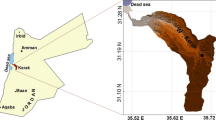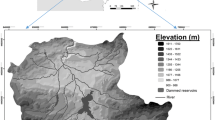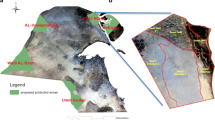Abstract
Agroforestry is one of the preferred land-use options for smallholder farms in tropical landscapes due to its ability to increase land productivity and protect soil from erosion. We investigated the impacts of agroforestry and traditional monocropping systems on the spatial patterns of soil erosion risk in three catchment areas of Claveria, the Philippines, using WaTEM/SEDEM, a spatially distributed soil erosion model. The model predicts soil loss in catchments based on the Revised Universal Soil Loss Equation (RUSLE) by taking into account the influences of rainfall, soil erodibility, vegetation cover and 2-dimensional variations in landscape structure. The predicted soil erosion rates were transformed into risk values in order to identify areas with higher risk for erosion. Model results indicate a large spatial variability in soil erosion risk patterns, with higher risks occurring on slopes greater than 8% on land under non-agroforestry use. The soil erosion risk maps were used to formulate site-specific agroforestry recommendations for future landscape amelioration plans.





Similar content being viewed by others
References
Agus F, Garrity DP, Cassel DK, Mercado A (1999) Grain crop response to contour hedgerow systems on sloping Oxisols. Agrofor Syst 42:107–120
Asio VB, Jahn R, Perez FO, Navarrete IA, Abit SMJ (2009) A review of soil degradation in the Philippines. Ann Trop Res 31:69
Bakker MM, Govers G, van Doom A, Quetier F, Chouvardas D, Rounsevell M (2008) The response of soil erosion and sediment export to land-use change in four areas of Europe: the importance of landscape pattern. Geomorphology 98:213–226
Bertomeu M, Bertomeu M, Gimenez JC (2006) Improving adoptability of farm forestry in the Philippine uplands: a linear programming model. Agrofor Syst 68:81–91
Bureau of Soils (1985) Detailed reconnaissance soil survey suitability classification: Claveria complementation project, Claveria, Misamis oriental. Bureau of soils, Manila
Chao-Yuan L, Wen-Tzu L, Wen-Chieh C (2002) Soil erosion prediction and sediment yield estimation: the Taiwan experience. Soil Tillage Res 68:143–152
Cohen MJ, Shepherd KD, Walsh MG (2005) Empirical reformation of the universal soil loss equation for erosion risk assessment in a tropical watershed. Geoderma 124:235–252
Comprehensive land Use Plan of Claveria (2000) Claveria municipal development council, Claveria, Misamis Oriental
Cramb RA (2001) Soil conservation technologies for smallholder farming systems in the Philippine uplands: a socioeconomic evaluation. ACIAR, Canberra
Dart PJ, Brown SM, Simpson JA, Harrison SR, Venn TJ (2000) Experience from trials of the sustainability and performance of Australian tree species. Socio-economic evaluation of the potential for Australian tree species in the Philippines. ACIAR, Australia
David WP (1988) Soil and water conservation planning: policy issues and recommendations. J Philipp Dev 15(26):47–84
Desmet PJJ, Govers G (1996) A GIS procedure for automatically calculating the USLE LS factor on topographically complex landscape units. J Soil Water Conserv 51:427–433
Ellis EA, Bentrup G, Schoeneberger MM (2004) Computer base tools for decision support in agroforestry: current state and future needs. Agrofor Syst 61:401–421
FAO (1993) Guidelines for land-use planning. Food and Agriculture Organization of the United Nations, Rome
Feng XM, Wang YF, Chen LD, Fu BJ, Bai GS (2010) Modeling soil erosion and its response to land-use change in hilly catchments of the Chinese Loess Plateau. Geomorphology 118:239–248
Garrity DP (2004) Agroforestry and the achievement of the Millennium development goals. New vistas in Agroforestry, A compendium for the 1st World Agroforestry Congress 2004. Kluwer Academic Publishers, Netherlands
Garrity DP, Amoroso VB, Koffa S, Catacutan D (2001) Innovations in participatory resource management to conserve tropical biodiversity. In seeking sustainability: challenges of Agricultural Development and Environmental Management in a Philippine Watershed. Los Baños: Philippine Council for Agriculture, Forestry and Natural Resources Research and Development
Grove M, Hohmann M (1992) Social forestry and GIS. J Forest 90:10–15
International Center for Research in Agroforestry (1995) Agroforestry at the service of farmers and the environment. Annual report. United Nations Avenue, Nairobi
Jha LK (1995) Advances in agroforestry. APH Publishing Corporation, New Delhi
Jordan G (1998) A public participation GIS for community forestry user groups in Nepal: putting people before technology. Empowerment, marginalization and public participation GIS, Santa Barbara
Kenneth G, Vergara M, Vergara NT (1990) Introduction to agroforestry. In: McDicken KG, Vergara NT (eds) Agroforestry classification and management. Wiley Interscience, New York, pp 1–30
Kim JB, Saunders P, Finn JT (2005) Rapid assessment of soil erosion in the Rio Lempa Basin, Central America, using the Universal soil loss equation and geographic information systems. Environ Manage 36:872–885
Leguedois S, Ellis TW, Hairsine PB, Tongway DJ (2008) Sediment trapping by a tree belt: processes and consequences for sediment delivery. Hydrol Process 22(17):3523–3534
Magbanua RD, Garrity DP (1990) Agroecosystems analysis of key upland farming system research site: Proceedings of the 1990 Acid Upland Design Workshop. IRRI, Los Baños
Magcale-Macandog DB, Ranola FM, Ranola RF Jr, Ani PAB, Vidal NB (2010) Enhancing the food security of upland farming households through agroforestry in Claveria, Misamis Oriental, Philippines. Agrofor Syst 79:327–342
Merritt WS, Croke BFW, Jakemana AJ, Letcher RA, Perez P (2004) A Biophysical toolbox for assessment and management of land and water resources in rural catchments in Northern Thailand. Ecol Model 171:279–300
Mitasova H, Hofierka J, Zlocha M, Iverson L (1996) Modelling topographic potential for erosion and deposition using GIS. Int J Geogr Inf Sci 10(5):629–641
Nekhay O, Arriaza M, Boerboom L (2009) Evaluation of soil erosion risk using Analytic Network process and GIS: a case study from Spanish mountain olive plantations. Environ Manage 90:3091–3104
Nelson RA, Cramb RA (1998) Economic incentives for farmers in the Philippine uplands to adopt hedgerow intercropping. Environ Manage 54:83–100
Nelson RA, Grist PG, Menz KM, Cramb RA, Paningbatan EP, Mamicpic MA (1997) A cost-benefit analysis of hedgerow intercropping in the Philippine uplands using the SCUAF model. Agrofor Syst 35:203–220
Paningbatan EP, Ciesiolka CA, Coughlan KJ, Rose CW (1995) Alley cropping for managing soil erosion of hilly lands in the Philippines. Soil Technol 8:193–204
Pritchett WL, Fisher RF (1985) Properties and management of soils, 2nd edn. Wiley, New York
Rahman MR, Shia ZH, Chongfaa C (2009) Soil erosion hazard evaluation – an integrated use of remote sensing, GIS and statistical approaches with biophysical parameters towards management strategies. Ecol Model 220:1724–1734
Renard KG, Foster GR, Weesies GA, McCool DK, Yoder DC (1997) Predicting soil erosion by water: a guide to conservation planning with the Revised Universal Soil Loss Equation (RUSLE). USDA Agricultural Handbook 703
Rijsdijk A, Bruijnzeel LA (1990) Erosion, sediment yield and land use patterns in the upper Konto watershed, East Java. Konto River Project Communication, vol 18, Konto River Project, Malang, pp 58, 59
RUSLE2 Software (2008) US Department of Agriculture. http://www.ars.usda.gov/Research/docs.htm?docid=6010. Accessed 24 June 2009
Sanchez PB, Oliver DP, Castillo HC, Kookana RS (2011) Nutrient and sediment concentrations in the Pagsanjan–Lumban catchment of Laguna de Bay, Philippines. Agr Water Manage. doi:10.1016/j.agwat.2011.07.011
Scherr SJ (1990) The diagnosis and design approach to agroforestry project planning and implementation examples from Western Kenya. Planning for Agroforestry, Budd WW, Dichhart I, Hardesty LH, Steiner F. Elsevier, Amsterdam
Shamshad A, Azhari MN, Isa MH, Wan Hussin WMA, Parida BP (2008) Development of an appropriate procedure for estimation of RUSLE EI30 index and preparation of erosivity maps for Pulau Penang in Peninsular Malaysia. Catena 72:423–432
Shively G (1999) Risks and returns from soil conservation: evidence from low income farms in the Philippines. Agr Econ 21:53–67
Sombatpanit S (1992) Soil conservation in Thailand. Aust J Soil Water Conserv 5(3):14–18
Thapa BB, Cassel DK, Garrity DP (1999) Ridge tillage and contour natural grass barrier strips reduce tillage erosion. Soil Tillage Res 51:341–356
Van Oost K, Govers G, Desmet P (2000) Evaluating the effects of changes in landscape structure on soil erosion by water and tillage. Landscape Ecol 15:577–589
Van Rompaey A, Verstraeten G, van Oost K, Govers G, Poesen J (2001) Modelling mean annual sediment yield using a distributed approach. Earth Surf Proc Land 26:1221–1236
Verstraeten G (2006) Regional scale modeling of hillslope sediment delivery with SRTM elevation data. Geomorphology 81:128–140
Verstraeten G, Van Oost K, Van Rompaey A, Poesen J, Govers G (2002) Evaluating an integrated approach to catchment management to reduce soil loss and sediment pollution through modelling. Soil Use Manage 18:386–394
WaTEM/SEDEM Manual (2006) KU Leuven, Physical and Regional Geography Research Group
White S (1996) Erosion, sediment delivery and sediment yield patterns in the Philippines. In: Erosion and sediment yield: global and regional perspectives, Proceedings of the exeter symposium, July 1996. IAHS Publisher no 236, 1996
Wischmeier WH, Smith DD (1978) Predicting rainfall erosion losses. Agricultural handbook No. 537. USDA-Science and education administration. Washington, DC pp 58
Young A (1989) Agroforestry for soil conservation. CAB International, Oxford
Ziegler AD, Giambelluca TW, Tran LT, Vana TT, Nullet NA, Fox J, Vien TD, Pinthong J, Maxwell JF, Evett S (2004) Hydrological consequences of landscape fragmentation in mountainous northern Vietnam: evidence of accelerated overland flow generation. J Hydrol 287:124–146
Acknowledgments
We appreciate the support of the people of Claveria; the Flemish Interuniversity Council – University Cooperation for Development Program (VLIR-UOS) and the Vrije Universiteit Brussel (VUB) for the funding; Dr. Damasa Magcale-Macandog of the University of the Philippines Los Baños and the World Agroforestry Centre in Claveria for providing logistical support; and Mr. Elezar Estenzo for his excellent facilitation skills.
Author information
Authors and Affiliations
Corresponding author
Rights and permissions
About this article
Cite this article
Delgado, M.E.M., Canters, F. Modeling the impacts of agroforestry systems on the spatial patterns of soil erosion risk in three catchments of Claveria, the Philippines. Agroforest Syst 85, 411–423 (2012). https://doi.org/10.1007/s10457-011-9442-z
Received:
Accepted:
Published:
Issue Date:
DOI: https://doi.org/10.1007/s10457-011-9442-z




